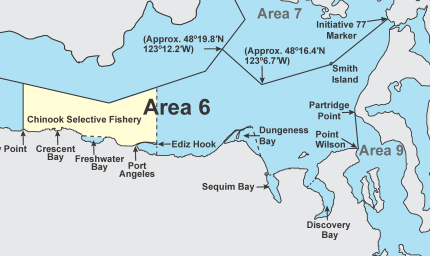DateJul 21, 2022Contact
Contact: Fish Program, 360-902-2700
Public Affairs contact: Mark Yuasa, 360-902-2262
OLYMPIA – Salmon fishing at Sekiu (Marine Area 5) returns to permanent fishing rules beginning July 25 after Washington Department of Fish and Wildlife (WDFW) fishery managers determined enough Chinook remained in the recreational catch quota following initially high catch rates.
Now that catch rates have decreased since the opener, WDFW can relax those restrictions again, allowing for more days to be open. Estimates for the Sekiu summer Chinook fishery through July 17 indicate the fishery has reached 40% of the legal-size encounters (2,967 of 7,342 fish).
“What happened in Sekiu this year is a great example of how WDFW staff work closely with constituents to manage fisheries and ensure seasons last,” said Kirsten Simonsen, Ph.D., WDFW’s Puget Sound recreational salmon manager. “While additional restrictions are never easy, we worked closely with members of the Sekiu fishing community to craft a fishery that worked for them.”
Sekiu will be open daily through Aug. 15 for salmon fishing. Daily limit is 2, with up to 1 hatchery Chinook. Chinook minimum size is 22". Other salmon species no minimum size. Release wild Chinook, wild coho, and chum. The Sekiu salmon fishery is scheduled to switch to Chinook non-retention on Aug. 16. Season may close earlier if Chinook guideline is attained.

The Marine Area 6 Chinook Selective Fishery Area is open Wednesdays through Saturdays only from beginning July 24 through Aug. 15 west of a true north/south line through the #2 Buoy immediately east of Ediz Hook, excluding Port Angeles Harbor and Freshwater Bay areas. A reduction in days was recommended by Puget Sound Recreational Fishery Advisors and representatives of the Marine Area 6 community to extend the Chinook season as long as possible.
Estimates for the Marine Area 6 Chinook Selective Fishery Area through July 17 indicate the fishery has reached 65% of the legal-size encounters (6,155 of 9,400 fish) and catch rates have been high to date.
On the days open the Marine Area 6 Chinook Selective Fishery Area daily limit is 2, with up to 1 hatchery Chinook. Chinook minimum size is 22”. Other salmon species, no minimum size. Release wild Chinook, wild coho and chum.
Puget Sound salmon seasons are a result of an annual collaborative state and tribal salmon season-setting process known as North of Falcon. To view the Puget Sound salmon fishery guidelines and quotas, visit https://wdfw.wa.gov/fishing/reports/creel/seasonal#ps-summer-chinook.
To support conservation objectives, in areas where multiple salmon stocks overlap—including the San Juan Islands and throughout Puget Sound—state and tribal fisheries managers must abide by harvest quotas and allowable impacts that are federally approved by the National Marine Fisheries Service based on agreed-upon run forecasts prior to the fishing season.
Given this federal oversight and the challenge of accurately assessing individual salmon stocks in a mixed-stock system, WDFW cannot increase salmon harvest quotas or encounter limits while fishing seasons are underway. However, salmon managers can add or extend fishing opportunities when available salmon harvest quota and encounter limits allow, as is the case with this extension.
Several other marine areas are currently open for salmon fishing and can be found on the WDFW website at https://wdfw.wa.gov/fishing/management/north-falcon/summaries. Additional information about this year's sport salmon fisheries and the North of Falcon salmon season setting process can be found at https://wdfw.wa.gov/fishing/management/north-falcon.
WDFW fishery managers continue to call on salmon anglers to submit voluntary Salmon Trip Reports to help to increase the amount of data available for in-season management. These trip reports are just one tool in a suite of options fisheries managers use to collect biological and fishery data for Puget Sound salmon. Other monitoring tools include dockside sampling, test fishing, and boat surveys. Anglers can complete the voluntary Salmon Trip Report Form online at https://str.wdfw-fish.us/home or visit the WDFW website at https://wdfw.wa.gov/licenses/fishing/trip-reporting to download a paper copy.
The Washington Department of Fish and Wildlife works to preserve, protect and perpetuate fish, wildlife and ecosystems while providing sustainable fish and wildlife recreational and commercial opportunities.
Individuals who need to receive this information in an alternative format, language, or who need reasonable accommodations to participate in WDFW-sponsored public meetings or other activities may contact the Title VI/ADA Compliance Coordinator by phone at 360-902-2349, TTY (711), or email (Title6@dfw.wa.gov). For more information, see https://wdfw.wa.gov/accessibility/requests-accommodation.
Original source can be found here.


 Alerts Sign-up
Alerts Sign-up